动词法:时态(讲解与练习)
- 格式:doc
- 大小:114.50 KB
- 文档页数:15
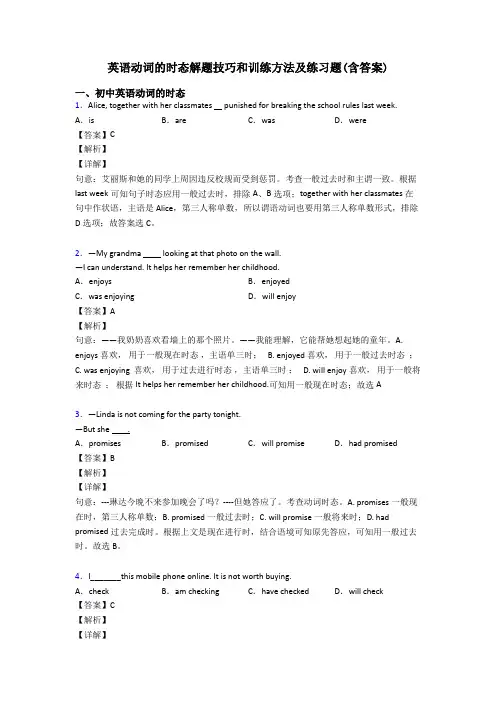
英语动词的时态解题技巧和训练方法及练习题(含答案)一、初中英语动词的时态1.Alice, together with her classmates punished for breaking the school rules last week. A.is B.are C.was D.were【答案】C【解析】【详解】句意:艾丽斯和她的同学上周因违反校规而受到惩罚。
考查一般过去时和主谓一致。
根据last week可知句子时态应用一般过去时,排除A、B选项;together with her classmates在句中作状语,主语是Alice,第三人称单数,所以谓语动词也要用第三人称单数形式,排除D选项;故答案选C。
2.—My grandma looking at that photo on the wall.—I can understand. It helps her remember her childhood.A.enjoys B.enjoyedC.was enjoying D.will enjoy【答案】A【解析】句意:——我奶奶喜欢看墙上的那个照片。
——我能理解,它能帮她想起她的童年。
A. enjoys喜欢,用于一般现在时态,主语单三时; B. enjoyed 喜欢,用于一般过去时态;C. was enjoying 喜欢,用于过去进行时态,主语单三时;D. will enjoy喜欢,用于一般将来时态;根据It helps her remember her childhood.可知用一般现在时态;故选A3.—Linda is not coming for the party tonight.—But she _.A.promises B.promised C.will promise D.had promised【答案】B【解析】【详解】句意:---琳达今晚不来参加晚会了吗?----但她答应了。
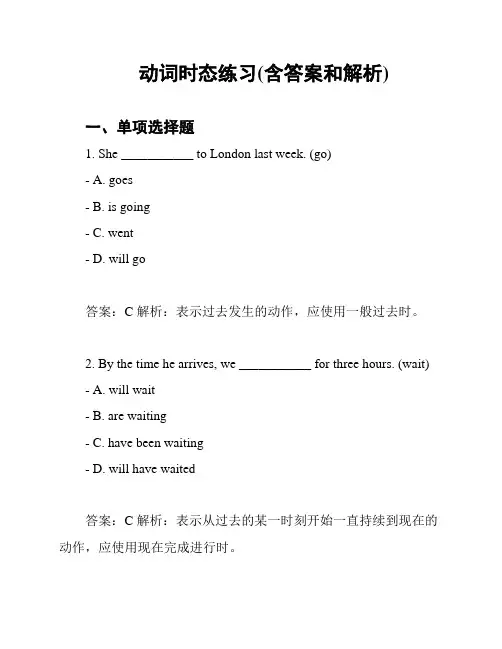
动词时态练习(含答案和解析)一、单项选择题1. She ___________ to London last week. (go)- A. goes- B. is going- C. went- D. will go答案:C 解析:表示过去发生的动作,应使用一般过去时。
2. By the time he arrives, we ___________ for three hours. (wait)- A. will wait- B. are waiting- C. have been waiting- D. will have waited答案:C 解析:表示从过去的某一时刻开始一直持续到现在的动作,应使用现在完成进行时。
3. They ___________ to the new house until next week. (not move)- A. don't move- B. didn't move- C. won't move- D. haven't moved答案:C 解析:表示将来某一时刻之前不会发生的动作,应使用一般将来时的否定形式。
4. I ___________ TV when he ___________ the room. (watch, enter)- A. was watching, entered- B. watched, entered- C. am watching, enters- D. watched, enters答案:A 解析:表示过去某一时间点正在进行的动作,此时另一个动作突然发生,应使用过去进行时和一般过去时。
5. She ___________ in the garden when it ___________ raining. (work, start)- A. was working, started- B. worked, started- C. is working, starts- D. works, starts答案:A 解析:表示过去某一时间点正在进行的动作,此时另一个动作突然发生,应使用过去进行时和一般过去时。
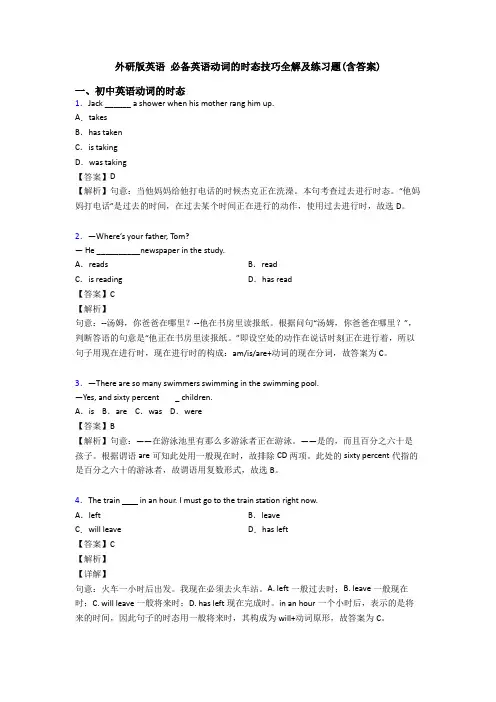
外研版英语必备英语动词的时态技巧全解及练习题(含答案)一、初中英语动词的时态1.Jack ______ a shower when his mother rang him up.A.takesB.has takenC.is takingD.was taking【答案】D【解析】句意:当他妈妈给他打电话的时候杰克正在洗澡。
本句考查过去进行时态。
“他妈妈打电话”是过去的时间,在过去某个时间正在进行的动作,使用过去进行时,故选D。
2.—Where’s your father, Tom?— He __________newspaper in the study.A.reads B.readC.is reading D.has read【答案】C【解析】句意:--汤姆,你爸爸在哪里?--他在书房里读报纸。
根据问句“汤姆,你爸爸在哪里?”,判断答语的句意是“他正在书房里读报纸。
”即设空处的动作在说话时刻正在进行着,所以句子用现在进行时,现在进行时的构成:am/is/are+动词的现在分词,故答案为C。
3.—There are so many swimmers swimming in the swimming pool.—Yes, and sixty percent _ children.A.is B.are C.was D.were【答案】B【解析】句意:——在游泳池里有那么多游泳者正在游泳。
——是的,而且百分之六十是孩子。
根据谓语are可知此处用一般现在时,故排除CD两项。
此处的sixty percent代指的是百分之六十的游泳者,故谓语用复数形式,故选B。
4.The train in an hour. I must go to the train station right now.A.left B.leaveC.will leave D.has left【答案】C【解析】【详解】句意:火车一小时后出发。
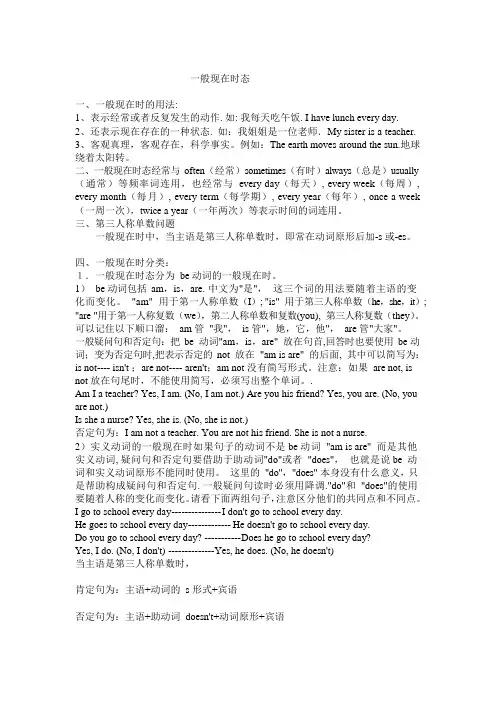
一般现在时态一、一般现在时的用法:1、表示经常或者反复发生的动作. 如: 我每天吃午饭. I have lunch every day.2、还表示现在存在的一种状态. 如:我姐姐是一位老师.My sister is a teacher.3、客观真理,客观存在,科学事实。
例如:The earth moves around the sun.地球绕着太阳转。
二、一般现在时态经常与often(经常)sometimes(有时)always(总是)usually (通常)等频率词连用,也经常与every day(每天), every week(每周), every month(每月), every term(每学期), every year(每年), once a week (一周一次),twice a year(一年两次)等表示时间的词连用。
三、第三人称单数问题一般现在时中,当主语是第三人称单数时,即常在动词原形后加-s 或-es。
四、一般现在时分类:1.一般现在时态分为be 动词的一般现在时。
1)be 动词包括am,is,are. 中文为"是",这三个词的用法要随着主语的变化而变化。
"am" 用于第一人称单数(I); "is" 用于第三人称单数(he,she,it); "are "用于第一人称复数(we),第二人称单数和复数(you), 第三人称复数(they)。
可以记住以下顺口溜:am 管"我",is 管",她,它,他",are 管"大家"。
一般疑问句和否定句:把be 动词"am,is,are" 放在句首,回答时也要使用be 动词;变为否定句时,把表示否定的not 放在"am is are" 的后面, 其中可以简写为:is not---- isn't ;are not---- aren't;am not 没有简写形式。
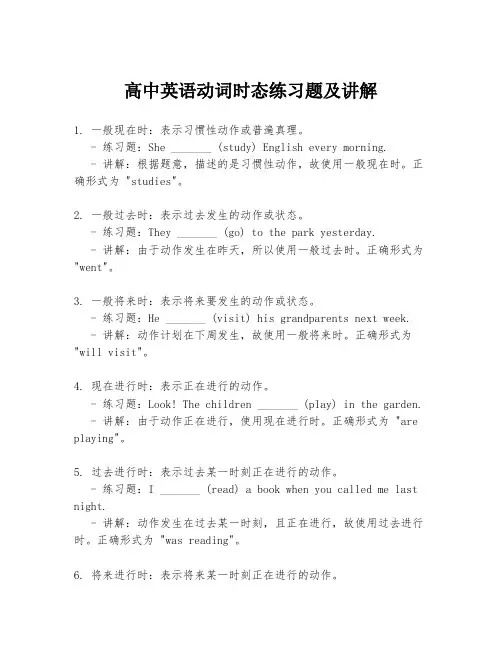
高中英语动词时态练习题及讲解1. 一般现在时:表示习惯性动作或普遍真理。
- 练习题:She _______ (study) English every morning.- 讲解:根据题意,描述的是习惯性动作,故使用一般现在时。
正确形式为 "studies"。
2. 一般过去时:表示过去发生的动作或状态。
- 练习题:They _______ (go) to the park yesterday.- 讲解:由于动作发生在昨天,所以使用一般过去时。
正确形式为"went"。
3. 一般将来时:表示将来要发生的动作或状态。
- 练习题:He _______ (visit) his grandparents next week. - 讲解:动作计划在下周发生,故使用一般将来时。
正确形式为"will visit"。
4. 现在进行时:表示正在进行的动作。
- 练习题:Look! The children _______ (play) in the garden. - 讲解:由于动作正在进行,使用现在进行时。
正确形式为 "are playing"。
5. 过去进行时:表示过去某一时刻正在进行的动作。
- 练习题:I _______ (read) a book when you called me last night.- 讲解:动作发生在过去某一时刻,且正在进行,故使用过去进行时。
正确形式为 "was reading"。
6. 将来进行时:表示将来某一时刻正在进行的动作。
- 练习题:She _______ (be) at a meeting at this time tomorrow.- 讲解:动作将在将来某一时刻进行,使用将来进行时。
正确形式为 "will be"。
7. 现在完成时:表示过去发生的动作对现在有影响或结果。
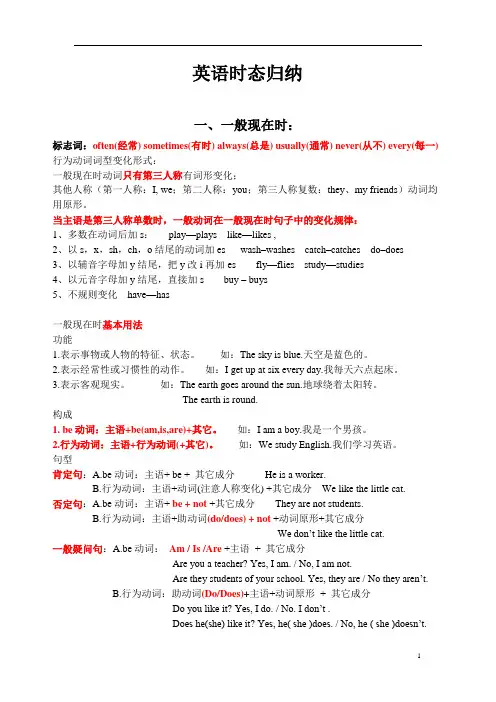
英语时态归纳一、一般现在时:标志词:often(经常) sometimes(有时) always(总是) usually(通常) never(从不) every(每一)行为动词词型变化形式:一般现在时动词只有第三人称有词形变化;其他人称(第一人称:I, we;第二人称:you;第三人称复数:they、my friends)动词均用原形。
当主语是第三人称单数时,一般动词在一般现在时句子中的变化规律:1、多数在动词后加s:play—plays like—likes ,2、以s,x,sh,ch,o结尾的动词加es wash–washes catch–catches do–does3、以辅音字母加y结尾,把y改i再加es fly—flies study—studies4、以元音字母加y结尾,直接加s buy – buys5、不规则变化have—has一般现在时基本用法功能1.表示事物或人物的特征、状态。
如:The sky is blue.天空是蓝色的。
2.表示经常性或习惯性的动作。
如:I get up at six every day.我每天六点起床。
3.表示客观现实。
如:The earth goes around the sun.地球绕着太阳转。
The earth is round.构成1. be动词:主语+be(am,is,are)+其它。
如:I am a boy.我是一个男孩。
2.行为动词:主语+行为动词(+其它)。
如:We study English.我们学习英语。
句型肯定句:A.be动词:主语+ be + 其它成分He is a worker.B.行为动词:主语+动词(注意人称变化) +其它成分We like the little cat.否定句:A.be动词:主语+ be + not+其它成分They are not students.B.行为动词:主语+助动词(do/does) + not+动词原形+其它成分We don’t like the little cat.一般疑问句:A.be动词:Am / Is /Are +主语+ 其它成分Are you a teacher? Yes, I am. / No, I am not.Are they students of your school. Yes, they are / No they aren’t.B.行为动词:助动词(Do/Does)+主语+动词原形+ 其它成分Do you like it? Yes, I do. / No. I don’t .Does he(she) like it? Yes, he( she )does. / No, he ( she )doesn’t.特殊疑问句:疑问词+ 一般疑问句A.be动词:How many students are there in your school?B.行为动词:What do you usually do on Sunday?一般现在时动词be和have的变化形式1.动词Be 叫连系动词, 用法:第一人称单数用am,第三人称单数用is,其它人称用are。
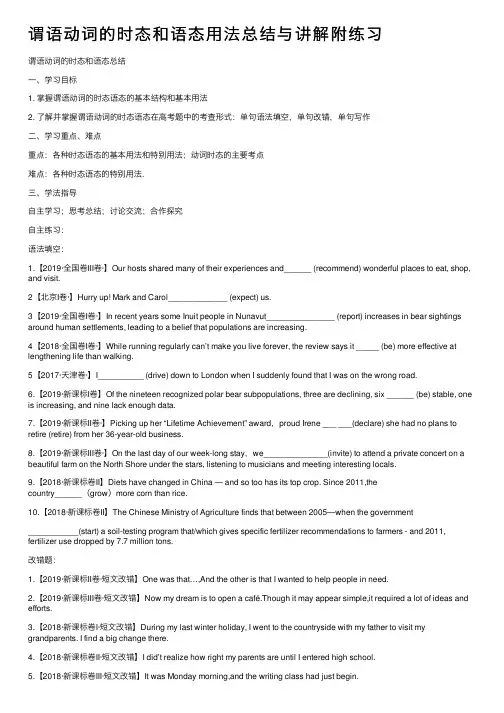
谓语动词的时态和语态⽤法总结与讲解附练习谓语动词的时态和语态总结⼀、学习⽬标1. 掌握谓语动词的时态语态的基本结构和基本⽤法2. 了解并掌握谓语动词的时态语态在⾼考题中的考查形式:单句语法填空,单句改错,单句写作⼆、学习重点、难点重点:各种时态语态的基本⽤法和特别⽤法;动词时态的主要考点难点:各种时态语态的特别⽤法.三、学法指导⾃主学习;思考总结;讨论交流;合作探究⾃主练习:语法填空:1.【2019·全国卷III卷·】Our hosts shared many of their experiences and______ (recommend) wonderful places to eat, shop, and visit.2【北京I卷·】Hurry up! Mark and Carol_____________ (expect) us.3【2019·全国卷I卷·】In recent years some Inuit people in Nunavut_______________ (report) increases in bear sightings around human settlements, leading to a belief that populations are increasing.4【2018·全国卷I卷·】While running regularly can’t make you live forever, the review says it _____ (be) more effective at lengthening life than walking.5【2017·天津卷·】I__________ (drive) down to London when I suddenly found that I was on the wrong road.6.【2019·新课标I卷】Of the nineteen recognized polar bear subpopulations, three are declining, six ______ (be) stable, one is increasing, and nine lack enough data.7.【2019·新课标II卷·】Picking up her “Lifetime Achievement” award,proud Irene ___ ___(declare) she had no plans to retire (retire) from her 36-year-old business.8.【2019·新课标III卷·】On the last day of our week-long stay,we______________(invite) to attend a private concert on a beautiful farm on the North Shore under the stars, listening to musicians and meeting interesting locals.9.【2018·新课标卷II】Diets have changed in China — and so too has its top crop. Since 2011,thecountry______(grow)more corn than rice.10.【2018·新课标卷II】The Chinese Ministry of Agriculture finds that between 2005—when the government___________(start) a soil-testing program that/which gives specific fertilizer recommendations to farmers - and 2011, fertilizer use dropped by 7.7 million tons.改错题:1.【2019·新课标II卷·短⽂改错】One was that…,And the other is that I wanted to help people in need.2.【2019·新课标III卷·短⽂改错】Now my dream is to open a café.Though it may appear simple,it required a lot of ideas and efforts.3.【2018·新课标卷I·短⽂改错】During my last winter holiday, I went to the countryside with my father to visit my grandparents. I find a big change there.4.【2018·新课标卷II·短⽂改错】I did’t realize how right my parents are until I entered high school.5.【2018·新课标卷III·短⽂改错】It was Monday morning,and the writing class had just begin.6.【2017·新课标卷III·短⽂改错】I had grown not only physically,but also mentally in the past few years.思考总结:动词的时态和语态概述:1.含义:动词的时态和语态是英语___________的形式,表⽰动作发⽣的时间和所处的状态.2. 学习思路:1).时态和语态重在理解,注意语境;2).要建⽴时,体,语态概念;时---现在时,过去时,将来时,过去将来时(事情发⽣在什么时候,注意主从句)体---⼀般体,进⾏体,完成体,完成进⾏体(动作处于什么状态;经常/进⾏/完成等)语态---主动,被动(主语和动词的关系,主谓or动宾)3.动词的时态和语态解题技巧:1)时间标志词法——不同的时态有与其搭配的时间词汇和短语,这些时间标志词或短语会提⽰应使⽤何种语态.2)语境推断法----有时句中⽆时间标志词或短语,这时需要联系主句或分句中的谓语并结合句意综合判断,推测出使⽤何种时态.3)固定句型提⽰法----在⼀些句型中,使⽤何种时态往往有其规律,判断句型有助于解答时态题,但注意理解句意仍是前提.①It/This is the +序数词+time+that从句(现在完成时)It/This was the +序数词+time+that从句(过去完成时)②It is/ has been+⼀段时间+since从句(⼀般过去时)It was/ had been+⼀段时间+since从句(过去完成时)③Was/were about to do…when从句(⼀般过去时)④Was/were doing…when从句(⼀般过去时)⑤It will be+⼀段时间+before从句(⼀般现在时)It was+⼀段时间+before从句(⼀般过去时)⑥Hardly had…done…when从句(⼀般过去时)No sooner had…done…than从句(⼀般过去时)⑦祈使句+and/or+陈述句(常⽤⼀般将来时)⑧while引导的时间状语从句中谓语动词为延续性动词,时态多为现在进⾏时或过去进⾏时动词的时态和语态详解:⼀、动词的时态:1.⼀般现在时谓语动词的结构:______________________1)表⽰现状、性质、状态和经常性的或习惯性的动作。
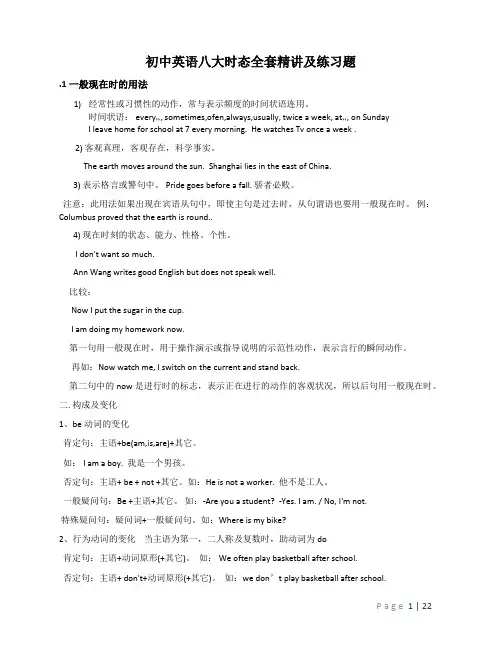
初中英语八大时态全套精讲及练习题.1 一般现在时的用法1)经常性或习惯性的动作,常与表示频度的时间状语连用。
时间状语: every…, sometimes,ofen,always,usually, twice a week, at…, on SundayI leave home for school at 7 every morning. He watches Tv once a week .2) 客观真理,客观存在,科学事实。
The earth moves around the sun. Shanghai lies in the east of China.3) 表示格言或警句中。
Pride goes before a fall. 骄者必败。
注意:此用法如果出现在宾语从句中,即使主句是过去时,从句谓语也要用一般现在时。
例:Columbus proved that the earth is round..4) 现在时刻的状态、能力、性格、个性。
I don't want so much.Ann Wang writes good English but does not speak well.比较:Now I put the sugar in the cup.I am doing my homework now.第一句用一般现在时,用于操作演示或指导说明的示范性动作,表示言行的瞬间动作。
再如:Now watch me, I switch on the current and stand back.第二句中的now是进行时的标志,表示正在进行的动作的客观状况,所以后句用一般现在时。
二. 构成及变化1、be动词的变化肯定句:主语+be(am,is,are)+其它。
如: I am a boy. 我是一个男孩。
否定句:主语+ be + not +其它。
如:He is not a worker. 他不是工人。
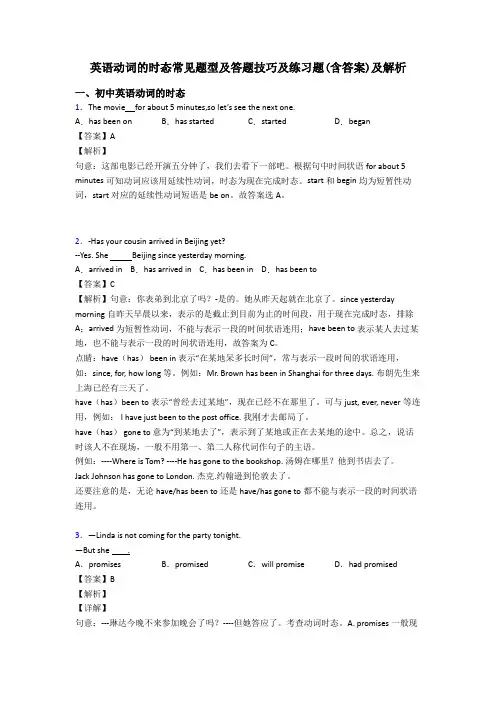
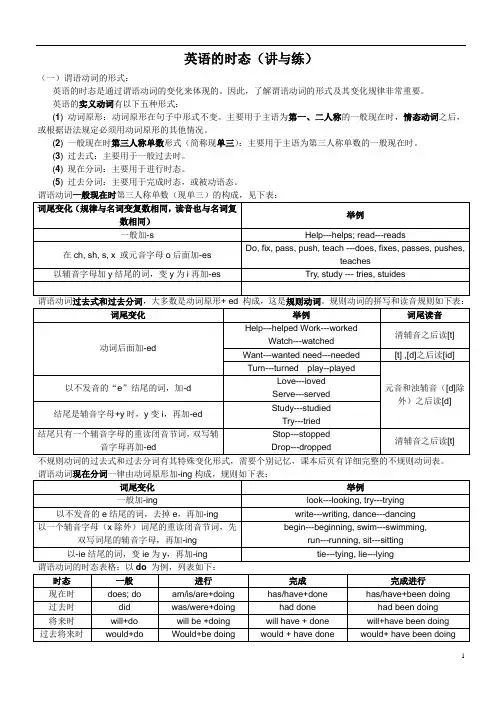
英语的时态(讲与练)(一)谓语动词的形式:英语的时态是通过谓语动词的变化来体现的。
因此,了解谓语动词的形式及其变化规律非常重要。
英语的实义动词有以下五种形式:(1) 动词原形:动词原形在句子中形式不变。
主要用于主语为第一、二人称的一般现在时,情态动词之后,或根据语法规定必须用动词原形的其他情况。
(2) 一般现在时第三人称单数形式(简称现单三):主要用于主语为第三人称单数的一般现在时。
(3) 过去式:主要用于一般过去时。
(4) 现在分词:主要用于进行时态。
(5) 过去分词:主要用于完成时态,或被动语态。
(二)谓语动词的时态:“时态”就是通过谓语动词的形态变化,来表达动作发生的时间(现在、过去、将来、过去将来)及所处的状态(一般、进行、完成、完成进行)。
1、一般现在时(1)构成:通常以动词原形表示。
主语为第三人称单数时,用单三形式。
(2)用法:1)表示现状、性质、状态和经常的或习惯性的动作。
He has an uncle.他有个叔叔。
Autumn follows summer.夏天之后是秋天。
这些动词可与often, usually, always, sometimes, every day, once a week, on Sundays, never 等表示经常性或习惯性的时间状语连用。
例如:Do you often go to the cinema? 你经常去看电影吗?Tom does not study as hard as Jane. 汤姆在学习方面不如简努力。
My father never takes a bus; he walks to his office.我父亲从来不坐公共汽车,他走着去上班。
2)表示客观现实或普遍真理。
The sun rises in the east. 太阳从东方升起。
A horse is a useful animal. 马是一种有用的动物。
When Winter comes, can Spring be far behind? 冬天来了,春天还会远吗?(英国浪漫主义诗人雪莱的名句。
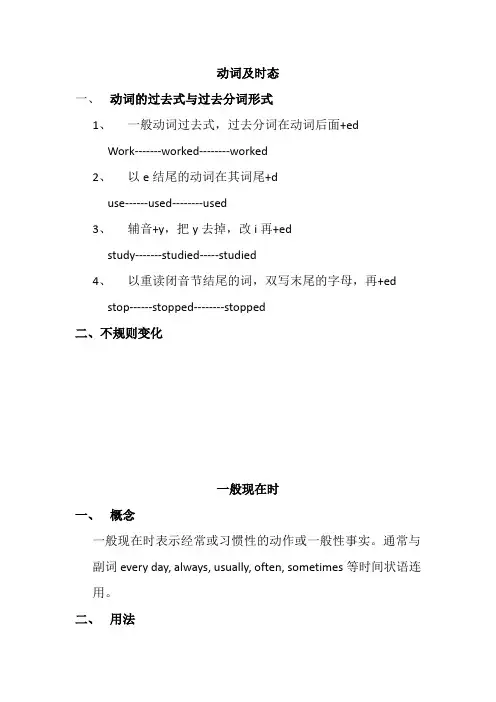
动词及时态一、动词的过去式与过去分词形式1、一般动词过去式,过去分词在动词后面+edWork-------worked--------worked2、以e结尾的动词在其词尾+duse------used--------used3、辅音+y,把y去掉,改i再+edstudy-------studied-----studied4、以重读闭音节结尾的词,双写末尾的字母,再+edstop------stopped--------stopped二、不规则变化一般现在时一、概念一般现在时表示经常或习惯性的动作或一般性事实。
通常与副词every day, always, usually, often, sometimes等时间状语连用。
二、用法1、表示经常、习惯的动作或状态。
He usually goes to school at seven o’clock.She doesn’t speak English.2、表示现在状态和特长。
She is a student.My sister dances well.3、表示客观事实和普通真理。
Winter is colder than Summer.The earth moves around the sun.三、构成1、be动词:主语+be(am, is, are)+其他I am a boy.2、行为动词:主语+行为动词(+其他)We study English.当主语为第三人称单数(he, she, it)时,要在动词后加“-s”或“-es”或变“y”为“ies”如:Mary likes Chinese.She studies Chinese every day.四、否定句和一般疑问句1、be动词的变化否定句:主语+be+ not+其他。
He is not a worker.一般疑问句:Be+主语+其他。
Is he a worker?2、行为动词的变化否定句:主语+ don’t (doesn’t)+ 动词原形(+其他)I don’tlike bread.当主语为第三人称单数(he, she, it)时,要用doesn’t构成否定句He doesn’t like bread.一般疑问句:Do(Does)+主语+动词原形+其他Do you like bread?当主语为第三人称单数(he, she, it)时,要用does构成否定句Does he like bread?一般现在时练习一、选择正确的答案填空。
【英语】英语动词的时态解题技巧分析及练习题(含答案)含解析一、初中英语动词的时态1.— What do you think of the young lady?— She is hard-working. She ________ all her effort into her work before she got ill.A.has put B.put C.had put D.would put【答案】C【解析】试题分析:句意:你认为这位小姐怎样?她很勤奋。
她生病前把她所有的精力都投入到她的工作中。
根据时间状语从句before she got ill.可知主句该用过去完成时态,所以选C。
考点:考查动词时态。
2.Ken, can you turn down the music a little? I _________ to study for my test.A.am trying B.try C.tried D.have tried【答案】A【解析】句意:Ken,你能把音乐调小一点吗?我正在设法为我的考试学习。
根据语境可知用现在进行时,其结构是be doing的形式,短语try to do sth.表示设法做某事。
根据题意,故选A。
现在进行时的基本结构1肯定式:am/is/are+doing(现在分词)否定式:am/is/are not +doing(现在分词)一般疑问式:Am/Is/Are + 主语 +doing(现在分词)+ 其他特殊疑问式:特殊疑问词+一般疑问式They’re having a meeting now. 他们现在正在开会。
They aren't having a meeting now. 他们现在没有在开会。
Are they having a meeting now? 他们现在正在开会吗?What are they doing now? 他们现在正在做什么?3.—I’m not sure if my sister Vivian ____________ the driving test next week.— Please let me know if she ____________ it.A.has passed; passes B.passed ; will pass C.passes; has passed D.will pass; passes 【答案】D【解析】句意:-我不确定我姐妹Vivian下周是否可以通过驾驶考试。
(英语)英语动词的时态常见题型及答题技巧及练习题(含答案)及解析一、初中英语动词的时态1.--I didn't see you at Olympic Sports Centre this morning. What happened?-- Sorry, I the exchange students around our school then.A.showed B.was showing C.am showing D.will show【答案】B【解析】句意:——今天早上我在奥运会体育中心没有看见你。
发生了什么?——对不起,我那时正领着交换生参观我们学校。
根据时间副词then可知此处用过去进行时,故选B。
2.Her son Coke, but now he milk.A.used to drink; is used to drinking B.used to drinking; drinksC.is used to drinking; used to drink D.was used to drink; is drinking【答案】A【解析】【详解】句意:她儿子过去常喝可乐,但现在他习惯喝牛奶。
used to do过去常常做;be used to doing sth习惯于做某事;drinks喝,第三人称单数形式;is drinking现在进行时,根据转折词but,可知前句表示过去喝可乐,后句表示习惯于喝牛奶,故选A。
3.—Shall we play tennis now?—Sorry, I can’t. I my homework.A.do B.did C.have done D.am doing【答案】D【解析】句意:——我们现在打网球去好吗?——对不起,我不能去,我在做作业。
A. do 做,用于一般现在时态,主语复数时; B. did做,用于一般过去时态; C. have done 做,用于一般现在完成时态; D. am doing做,用于现在进行时态,主语是I时;根据now可知用现在进行时态,故选D4.I_______this mobile phone online. It is not worth buying.A.check B.am checking C.have checked D.will check【答案】C【解析】【详解】句意:我在网上查过这部手机。
动词法:时态综述时态是英语区别于中文最显著的特点。
在英语里,你每说一句话的同时,也要透露这句话的时间信息和状态信息,中文却不必如此。
我经常说,英语是一门很严谨的语言,时态就是体现。
中国人说惯了含含糊糊的中文,遇到英文这种严谨的语言时,常常不适应。
在这里和大家说明一下,本文主要讲解的是时态的基本规则,时态还有很多芝麻绿豆般细节的规则,大家可以查百度,我就不再啰嗦。
别人说的明白的我就不说了,我说说他们没说明白的——时态的本质,以及如何1小时看懂时态。
时态是什么很多人都很怕时态,这是因为大多数的语法书都把时和态混在一起讲。
所以你经常会看到什么“过去进行时”,“现在完成时”这样的描述。
我说句不客气的,把时态混在一起讲,不是故意难为人,就是写书的人水平不够。
其实时态要分开来看。
从现在开始,我要求你把时和态分开来说。
比如说,我希望你少说什么“现在完成时”之类的话,你应该说:现在时,完成态。
举例:She is a teacher. 现在时,一般态She was a teacher. 过去时,一般态She has been a teacher for 10 years. 现在时,完成态那么,时态有多少种呢?时有4种,态有4种,所以乘起来就是16种。
不过你不需要16种都掌握,你甚至一种都不需要掌握。
你只要会判断时和态就可以了。
时态就这么简单。
时英语语法里的时间有4种。
过去,现在,将来,过去将来。
1,过去将来时过去,现在,将来这三个概念都特别好理解,需要讲解的就是“过去将来”。
所谓过去将来,就是从过去的某一时间来看,将来要发生的事。
比如:她曾说她将会嫁给我。
She said she would marry me.将会本该用will,因为she said发生在过去,所以will也要变成would2,动词的过去式如何表达事情发生在过去?英语的方法就是把动词变个样,我们把这种变了样的动词叫做“过去式”。
比如:is – was(系词在英语里也被认为是一种特殊的动词)are – werelike – likedget – got现在式变成过去式,一般规则是动词后面加ed,郁闷的是,例外的情况特别多。
高中英语必修课----复习动词时态知识讲解及巩固练习题(含答案解析)概念引入动词的时态是英语中最重要的语法项目,也是高考重点热点之一,在英语句子中也是随处可见、随时要用的。
从学英语我们就开始学习和应用动词的时态,而在高二最后一个语法复习中,我们将重点学习现在完成进行时,并小结一下动词常用的10种时态形式及其用法。
先看下面句子:1.It is a great pleasure to meet you students from England,who are interestedin archaeology.2.We’ve been excavating here for many years and...3.We have found human and animal bones in those caves higher up the hill aswell as tools and other objects.4.Did they wear clothes made entirely of animal skins?5.An archaeologist is showing them round.这些句子中斜体词部分都是句子的谓语,谓语当然都有自己的时态。
句1是一般现在时,句2是现在完成进行时,句3是现在完成时,句4是一般过去时,句5是现在进行时。
例句中涉及到的时态只是时态的一部分,下面我们先学习本单元重点语法-----现在完成进行时。
由于篇幅限制,简单的例句将不提供汉语释义。
用法讲解现在完成进行时Ⅰ.构成:have/has+been+动词¬ing(第三人称单数用has,其他用have)Ⅱ.用法:现在完成进行时主要表示从过去某一时刻开始到现在一段时间里一直进行的动作,此动作可能仍在进行,也可能刚刚完成。
现在完成进行时所表示的动作具有持续性、暂时性和未完成性。
1.现在完成进行时表示动作的重复,有时所表示的动作并不是一直不停地进行,而是断断续续地重复。
【英语】中考英语动词的时态解题技巧和训练方法及练习题(含答案)一、初中英语动词的时态1.James with the Greens the White Tower Park if it tomorrow.A.are going to; isn’t rainy B.are going to; doesn’t rainC.is going to ; won’t rain D.is going to; isn’t rainy【答案】D【解析】试题分析:句意:如果明天不下雨,James将和格林夫妇去白塔公园。
If引导的条件状语从句,主句用一般将来时从句用一般现在时。
with the Greens在此是介词短语作后置定语真正的主语是James故谓语动词用单数。
根据句意,故选D。
考点:考查if引导的从句的用法2.—Shall we play tennis now?—Sorry, I can’t. I my homework.A.do B.did C.have done D.am doing【答案】D【解析】句意:——我们现在打网球去好吗?——对不起,我不能去,我在做作业。
A. do 做,用于一般现在时态,主语复数时; B. did做,用于一般过去时态; C. have done做,用于一般现在完成时态; D. am doing做,用于现在进行时态,主语是I时;根据now可知用现在进行时态,故选D3.We a few museums while we were in London.A.visit B.visitedC.have visited D.are visiting【答案】B【解析】句意:当我在伦敦时,我参观了几个博物馆。
A. visit 参观,用于一般现在时态,主语复数时; B. visited 参观,用于一般过去时态; C. have visited 参观,用于一般现在完成时态;D. are visiting 参观,用于现在进行时态,主语复数时;根据 while we were in London.可知主句用过去时态;故选B4.—How noisy it is outside!—Oh, I forgot to tell you. My neighbours ________ their houses.A.have decorated B.were decoratingC.are decorating D.will decorate【答案】C【解析】句意:——外面真吵!——哦,我忘了告诉你,我的邻居正在装饰他们的房子。
初中英语语法:动词时态讲解及练习初中英语语法:动词时态讲解及练动词时态专讲一、概说动词的时态历来是中考题中考查的重头戏之一。
测试重点放在根据特定语言环境区别使用一般现在时,一般过去时和现在完成时;一般现在时(过去时)与现在(过去)进行时;特定的时间状语中时态的使用;结合所获得的语言知识确定正确时态的能力等。
综上所述,动词的时态在中考测试中的地位非常重要。
因而考生在复备考中必须对本专题引起足够的重视。
构成时态二、各种时态的构成do / does一般现在时时态构成did一般过去时am / is / arewas / were现在完成时现在进行时一般将来时am / is / are + doinghave / has + doneshall / will + do曩昔完成时过去进行时过去将来时was / were + doingwould + dohad + donewas / were going + to doam / is / are going + to do普通目前时三、各种时态的用法1.透露表现经常性或气性的举措,常与透露表现频度的工夫状语连用。
时间状语:every day,every other day,sometimes,often,usually,on Sunday …I leave home for school at 7 _________________ (天天清晨).The Olympic Games are held ____________________ (每四年).What do you ____________ (平日) do when you are free on Sunday?2.用在客观真理,客观存在,科学事实或格言警句中。
The earth _________________ (绕着……转) the sun.Shanghai lies in the east of China.上海__________中国的东方。
动词法:时态综述时态和语态是高考的必考题,也是高中语法的重点。
由于中文不存在对应的时态概念,因此中国学生常常在学习时态的时候,总是无法很好的理解英语的思维方式。
因此,在解答时态题目的时候,必须适当的使用排除法,以增加做题的正确率。
(时态也是唯一只能用排除法来应对的题目类型)从近年来的出题规律看,单独考时态的题目并不多,这大大降低了时态类题目的难度,使得考生更容易判断出正确的选项。
什么是时态在平时的学习中,我们总是把时态和在一起来学习,这极大地增加了理解的难度,事实上,时态是由两个部分构成的。
1,四种时间概念。
a)现在时b)过去时c)将来时d)过去将来时I didn't know if he would come.She was sixty-six. In three years, she would be sixty-nine.2,四种状态概念。
a)一般态:既非进行也非完成;文学名著与客观事实。
b)进行态:表示动作的持续性发生。
c)完成态:在截止时间发生的时候,已经完成了的事情,对截止时间时发生的事情产生影响。
d)完成进行态:表示从过去到截止时间发生时,持续不断进行并将继续进行的状态。
解题策略●用时间排除错误选项。
【2011全国卷,29】When Alice came to, she did not know how long she ______ there.A. had been lyingB. has been lyingC. was lyingD. has lain分析:从题目上看,要填入选项的地方位于宾语从句之后,由于主句的时间是过去时,因此从句的时间只能是“过去时”,故而可以排除B和D两个表示“现在”时间的选项。
句意为“当Alice苏醒过来时,她不知道她在那儿躺了多久了。
”用以下第二步的判断方式可知,本题有明确截止动作“came to”,意思是苏醒,故使用完成态。
【答案A】【2011北京卷,27】—That must have been a long trip.—Yeah, it ______ us a whole week to get there.A. takesB. has takenC. tookD. was taking【答案】C【解析】句意为“那一定是长途旅行。
”“是的,我们花了整整一周时间才赶到那儿。
”题干中must have done是对过去的肯定推测,提示时间在过去,描述过去的情况,排除A和B,D项was taking进行时态表将来,但事实上事情已发生,这与题意不符,因此选C。
●用状态排除错误选项。
有的时候,用状态来辅助判断,更容易排除错误选项。
特别是在有完成态的题目中。
完成态的特点是必须有明确的“截止时间”,或至少有“截止动作”,事情如果是发生在截止时间或者截止动作之前,则一定是用完成态。
以下词常常用来说明截止时间。
So far 说明截止时间为“现在”in the last + 延续性时间说明截止时间为“现在”for + 延续性时间说明截止时间为“现在”since + 起点时间说明截止时间为“现在”by next + 终点时间说明截止时间为“将来”over the last + 延续时间说明的状态为“从过去某个时间到现在一直都”【2011天津卷,3】In the last few years thousands of films ______ all over the world.A.have producedB. have been producedC. are producingD. are being produced解析:句意为“在过去的几年时间里,全世界制作了成千上万部电影。
”in the last few years在最近的几年时间里,其实是从过去算到现在,是现在完成时的标志。
选B。
【2011湖南卷,30】It is the most instructive lecture that I ______ since I came to this school.A. attendedB. had attendedC. am attendingD. have attended解析:句意为“自从我到这个学校以来,这是我所听到的最有教育意义的演讲。
”since自从…以来,为完成态的标志性时间提示词。
另,since引导过去时的从句时,主句用现在完成时。
选D。
在此特别注意,任何情况下要启用“过去完成时态”,必须要有明确的“过去的过去”的时间提示,否则绝对不可以使用“过去完成时时态。
【2011全国卷II,9】If you don't like the drink you ____ just leave it and try a different one.A. orderedB. are orderingC. will orderD. had ordered解析:句意为“如果你不喜欢你所点的饮料,就把它放那儿,试试另一种。
”don't like the drink是现在时,点饮料是过去的动作,因此,用过去时或现在完成时,故选A。
在此缺乏“过去的过去”,因此虽然事情发生在“过去”,但不可以用过去完成时态。
【2011北京卷,21】Experiments of this kind ______ in both the U.S. and Europe well before the Second World War. (conduct experiments = 做实验)A. have conductedB. have been conductedC. had conductedD. had been conducted解析:句意为“就在二战爆发前,美国和欧洲都进行过这种实验。
”题干中出现the second war是过去的时间点,conduct这个动作发生在before the second war,很显然是过去的过去,因此使用过去完成时。
排除AB。
再考虑语态,主语experiment与conduct构成动宾关系,谓语使用被动形式。
答案D。
●用动词的数排除错误选项需要注意的是,近年来考察动词的数的题型——主谓一致,已经越来越少单独出题,而是常常和时态题混考,解题时如果发现明显的数的变化,也可以优先考虑,排除干扰项。
●用动词的语态排除错误选项语态题是最容易和时态混考的题目,因此解题时还应该注意语态,排除错误干扰项。
【2011上海春招,32】A lot of people often forget that oral exams _____ to test our communicative ability.A. designB. are designedC. are designingD. are being designed解析:句意为“很多人经常忘记设计口语测试是用来检测我们的交际能力的。
”oral exams与design的关系存在着被动,排除AC。
本题既非“进行”也非“完成”,故为一般态,选B。
●学会画时间轴在动词和时间较为复杂的题目中,可使用时间轴辅助解题,特别是遇到“过去的过去”的题型时,往往不提示过去截止时间而只提示过去截止动作,此时要注意使用时间轴辅助解题。
【2011山东卷,35】She was surprised to find the fridge empty; the child ______ everything!A. had been eatingB. had eatenC. have eatenD. have been eating【解析】句意为“她惊讶地发现冰箱里空空如也;她的孩子把里面的东西全吃光了!”通过时间轴可以看出,“吃光”这个动作发生在“发现”之前,前一句交代了过去时间,因此选择过去的过去。
故选B。
●根据上下文,对称解题有一些题目为对称式,这样的题目可绕过以上解题方法,直接判断。
【2011全国卷,24】I wasn’t sure if he was really interested or if he ______ polite.A. was just beingB. will just beC. had just beenD. would just be【解析】句意为“我不能确信他是真正感兴趣呢还是仅仅为了表示礼貌。
”句前wasn’t sure表明说话的起点是过去时,was really interested和was just being polite都是相一致的过去时。
答案A。
补充知识●将来时的特别形态be about to do sth.be to do sth时态练习1.—Bob has gone to California.—Oh, can you tell me when he ______ ?A. has leftB. leftC. is leavingD. would leave2.On her next birthday, Ann ______ married for twenty years.A. isB. has beenC. will beD. will have been3.I’m sure you will do better in the test because you ______ so hard this year.A. studiedB. had studiedC. will studyD. have been studying4.When I got on the bus, I ______ I had left my wallet at home.A. was realizingB. realizedC. have realizedD. would realize5.—I hear you ______ in a pub. What’s it like?—Well, it’s very hard work and I’m always tired, but I don’t mind.A. are workingB. will workC. were workingD. will be working6.—Tommy is planning to buy a car.—I know. By next month, he _____ enough for a used one.A. saves B .saved C. will save D. will have savedst month, the Japanese government expressed their thanks for the aid they______ from China.A. receiveB. are receivingC. have receivedD. had received8.Planning so far ahead ______ no sense—so many things will have changed bynext year. (make no sense = 毫无意义)A. madeB. is makingC. makesD. has made9.All visitors to this village ______ with kindness.A. treatB. are treatedC. are treatingD. had been treated10.—What a mistake!—Yes. I ______ his doing it another way, but without success.A. was suggestingB. will suggestC. would suggestD. had suggested11.That piece of music sounds quite familiar. Who ______ the piano upstairs?A. has playedB. playedC. playsD. is playing12.Look at th e pride on Tom’s face. He _____ to have been praised by the managerjust now.A. seemedB. seemsC. had seemedD. is seeming13.His first novel ______ good reviews since it came out last month.A. receivesB. is receivingC. will receiveD. has received14.John, what ______ in your hand?—Look! It’s a birthday gift for my grandma.A had you heldB are you holdingC do you holdD will you hold15.In 1492, Columbus ______ on one of the Bahama islands, but he mistook it for anisland off India.A. landsB. landedC. has landedD.had landed16.In the near future, more advances in the robot technology ______ by scentists.A. are makingB. are madeC. will makeD. will be made17.By the time Jack returned home from England, his son ______ from college.A. graduatedB. has graduatedC. had been graduatingD. had graduated18.We arrived at work in the morning and found that somebody _____ into the officeduring the night.A. brokeB. had brokenC. has brokenD. was breaking19.The country life he was used to _______ greatly since 1992.A. changeB. has changedC. changingD. have changed20.—Why weren't you at the meeting?—I _______ for a long distance call from my sister in America.A. was waitedB. was waitingC. has waitedD. have been waiting21.—Sadam, the former president of Iraq, was caught at last.—Really? Where _______ himself?A. has he hiddenB. had he hiddenC. was he hiddenD. has he been hiding22.Cathie came home happily, which suggested that she ______ the final exam.A. had passedB. passC. would passD. would have passed23.—Guess what, we've got our visas for a short-term visit to the UK this summer.—How nice! You _______ a different culture then.A. will be experiencingB. have experiencedC. have been experiencingD. will have experienced24.Christmas ______ near, so let's do shopping and get prepared for it.A. is drawingB. drawsC. drewD. has drawn解析:1.【2011北京卷,32】—Bob has gone to California.—Oh, can you tell me when he ______ ?A. has leftB. leftC. is leavingD. would leave【答案】B【解析】时为过去:Bob has gone to California,去的动作已经发生过,说明他离开的动作发生在过去,排除AC。